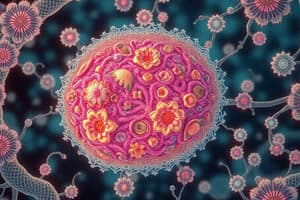Podcast
Questions and Answers
What does the endosymbiotic theory suggest about certain organelles?
What does the endosymbiotic theory suggest about certain organelles?
- They originated as independent prokaryotic cells engulfed by host cells. (correct)
- They originated from the fusion of eukaryotic cells.
- They evolved from archaea alone.
- They are solely found in prokaryotic cells.
Prokaryotic cells contain a nucleus.
Prokaryotic cells contain a nucleus.
False (B)
What is the primary function of the Golgi apparatus in eukaryotic cells?
What is the primary function of the Golgi apparatus in eukaryotic cells?
To modify, manufacture, and package transport vesicles.
The outer membrane of mitochondria is _____ while the inner membrane has folds called _____ that increase surface area.
The outer membrane of mitochondria is _____ while the inner membrane has folds called _____ that increase surface area.
Match the eukaryotic organelles with their functions:
Match the eukaryotic organelles with their functions:
What are the main components of the cytoskeleton?
What are the main components of the cytoskeleton?
Fimbrae are used by cells for locomotion.
Fimbrae are used by cells for locomotion.
The _____ is responsible for synthesizing lipids and detoxifying harmful substances in the cell.
The _____ is responsible for synthesizing lipids and detoxifying harmful substances in the cell.
Flashcards
Endosymbiotic Theory
Endosymbiotic Theory
A scientific theory that posits that certain eukaryotic organelles, such as mitochondria and chloroplasts, originated from independent prokaryotic cells that were engulfed by ancestral eukaryotic cells.
Prokaryotes
Prokaryotes
Single-celled organisms lacking a nucleus. They include bacteria and archaea.
Cell Wall (prokaryotic)
Cell Wall (prokaryotic)
The outermost layer of a prokaryotic cell, providing structural support and made of peptidoglycan.
Nucleus
Nucleus
Signup and view all the flashcards
Endoplasmic Reticulum (ER)
Endoplasmic Reticulum (ER)
Signup and view all the flashcards
Golgi Apparatus
Golgi Apparatus
Signup and view all the flashcards
Mitochondria
Mitochondria
Signup and view all the flashcards
Cytoskeleton
Cytoskeleton
Signup and view all the flashcards
Study Notes
Endosymbiotic Theory
- Certain eukaryotic organelles originated from independent prokaryotic cells.
- Both prokaryotes and eukaryotes have membrane-bound organelles, but prokaryotes lack a nucleus.
Prokaryotes
- Include bacteria and archaea.
- Have a nucleoid region containing their DNA.
- Possess various membrane-bound organelles:
- Plasma membrane: composed of phospholipids and proteins.
- Cell wall: provides structural support and is made of peptidoglycan.
- Glycocalyx: an outer coating that can be a slime layer.
- Flagella: for locomotion.
- Monotrichous: one flagella at one pole.
- Lophotrichous: multiple flagella at one pole.
- Peritrichous: flagella distributed all around the cell.
- Amphitrichous: one flagella at each pole.
- Ribosomes: composed of RNA and protein, responsible for protein synthesis.
Eukaryotes
- More complex organisms, including plants, animals, fungi, and protists.
- Possess a nucleus and other membrane-bound organelles.
Eukaryotic Organelles
- Nucleus:
- Contains most of the cell's genes.
- Houses chromatin, which forms chromosomes.
- Contains a nucleolus, the site of ribosomal RNA synthesis.
- Encased by a nuclear envelope, a double phospholipid bilayer.
- Possesses nuclear pores for regulating molecule passage.
- Has a nuclear lamina that maintains the nucleus's shape.
- Endoplasmic Reticulum:
- Smooth reticulum: synthesizes lipids, metabolizes carbohydrates, detoxifies, and stores calcium.
- Rough reticulum: secretes glycoproteins and distributes vesicles.
- Golgi apparatus: modifies, manufactures, and packages transport vesicles.
- Lysosomes:
- Digest macromolecules.
- Involved in:
- Phagocytosis: engulfing cells to form vacuoles.
- Phagolysosome: fusion of lysosomes and vacuoles.
- Autophagy: absorbing useless cellular components.
- Vacuoles:
- Food vacuoles.
- Contractile vacuoles: pump water.
- Central vacuoles: found in plant cells.
Other Eukaryotic Organelles
- Mitochondria:
- The site of cellular respiration, generating ATP (energy source).
- Has a smooth outer membrane and an inner membrane.
- Chloroplast:
- Found in plants and algae, contains chlorophyll.
- Includes thylakoids (sacs) and stroma (internal fluid).
- Peroxisome:
- Converts hydrogen peroxide to water.
- Cytoskeleton:
- Supports cells and maintains their shape.
- Composed of three types of fibers:
- Microtubules: thickest, control the beating of cilia and flagella.
- Microfilaments: thinnest, play a role in cell structure, organization, and movement.
Studying That Suits You
Use AI to generate personalized quizzes and flashcards to suit your learning preferences.




